European hazard symbols for chemicals are pictograms defined by the European Union for labelling chemical packaging (for storage and workplace) and containers (for transportation). They are standardised currently by the CLP/GHS classification.
YouTube Encyclopedic
-
1/3Views:39 5321 114488
-
GHS Safety Training Video - Globally Harmonised System Chemicals Safetycare
-
Hazard symbol
-
GHS hazard pictograms
Transcription
GHS hazard pictograms
- The European Union CLP Regulation (for "Classification, Labelling and Packaging") was introduced as EC Regulation 1272/2008. It is based on the GHS system, to secure for "physical, health and environment hazards".

- The European Agreement concerning the International Carriage of Dangerous Goods by Road (ADR) fixed harmonised pictograms for transportation. Vehicles carrying dangerous goods have to be fitted with orange signs, where the lower number identifies the substance, while the upper number is a key for the threat it may pose. See former pictograms below.
Former hazard pictograms (1999–2007)
The hazard symbols for chemicals were defined in Annex II of Directive 67/548/EEC. A consolidated list with translations into other EU languages was found in Directive 2001/59/EC (see § References).
| Hazard pictogram & mention, code | Substances examples |
|---|---|
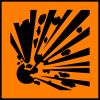 Explosive (E) Explosive (E) |
TNT, acetone peroxide, nitroglycerin, picric acid |
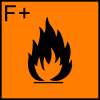 Extremely Flammable (F+) Extremely Flammable (F+) |
Hydrogen, acetylene, propane, butane, diethyl ether, carbon disulfide, acetaldehyde |
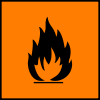 Highly Flammable (F) Highly Flammable (F) |
Ethanol, acetone, gasoline, hexamine, methanol |
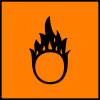 Oxidizing (O) Oxidizing (O) |
Oxygen, potassium nitrate, hydrogen peroxide, nitric acid, potassium permanganate |
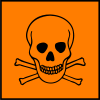 Toxic (T) Toxic (T) |
Sulfuric acid, TNT, Nitroglycerin, carbon disulfide, methanol, ammonia, formaldehyde |
 Very toxic (T+) Very toxic (T+) |
Prussic acid, nicotine, carbon monoxide, white phosphorus |
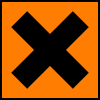 Harmful (Xn) Harmful (Xn) |
Hexamine, butane, naphtha, acetaldehyde |
 Irritant (Xi) Irritant (Xi) |
Sodium hypochlorite, acetone, ethanol |
 Corrosive (C) Corrosive (C) |
Sulfuric acid, Nitric acid, sodium hydroxide, ammonia, White phosphorus |
 Dangerous for the environment (N) Dangerous for the environment (N) |
Sulfuric acid, turpentine, lead, mercury, Crude oil |
The 'n' in Harmful (Xn) stands for the French word nocif (harmful) and the Italian word nocivo (noxious).
 Block magnet |
 Explosive |
 Poison |
 Ionizing radiation |
 Suspended load |
 Truck driving |
 Self ignition |
 Electromagnetic radiation |
 Tripping danger |
 Falling hazard |
 Biohazard |
 Health danger and irritant |
 Dangerous batteries |
 Explosive atmosphere |
 Pinch |
 Can tip over when moving |
 Automatic Startup |
 Hand pinching |
 Slippery |
 Driven by conveyor belt inside the track |
 Entanglement hazard |
 Corrosive |
 Gas bottle |
 Cold |
 Laser radiation |
 Potential danger |
 Flammable |
 Electrical danger |
 Hot surface |
 Magnetic field |
 Optical radiation |
|||||
References
- "Hazard symbols". MSDS Europe. p. http://www.msds-europe.com/id-487-hazard_symbols.html. Retrieved 23 August 2017.
External links
 Media related to Safety signs and Warning signs at Wikimedia Commons
Media related to Safety signs and Warning signs at Wikimedia Commons Media related to DIN 4844-2 warning signs and ISO 7010 safety signs at Wikimedia Commons
Media related to DIN 4844-2 warning signs and ISO 7010 safety signs at Wikimedia Commons
